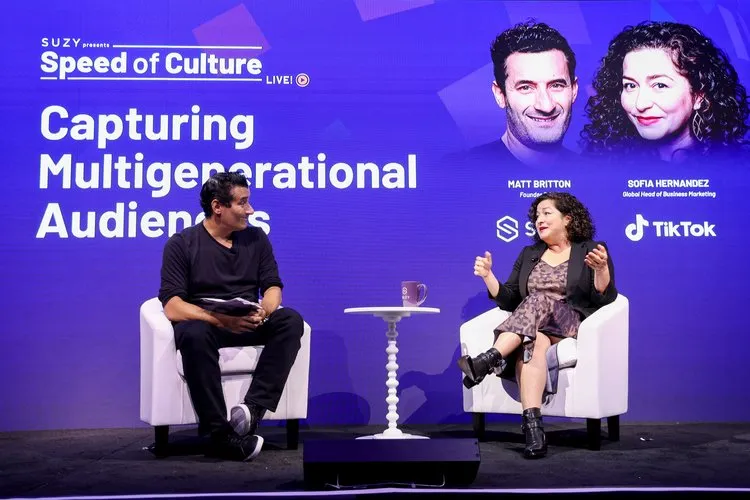Speed of Culture LIVE!
The inaugural edition of Speed of Culture LIVE! was held September 18th in NYC and convened a world-class roster of leaders and visionaries from some of the world’s most important brands and exciting startups. From here, you can catch up on each dynamic session and learn how to drive your business forward.
Stay tuned for the 2025 edition of Speed of Culture LIVE!

Delivering Instant Gratification with DoorDash’s Kofi Amoo-Gottfried
Hear how brands like DoorDash are adapting to meet consumer expectations for instant gratification, by leveraging technology and innovative strategies to deliver immediate satisfaction.
Speaker: Kofi Amoo-Gottfried, CMO, DoorDash
Moderator: Segun Oduolowu, Boston Globe

Capturing Multigenerational Audiences with TikTok’s Sofia Hernandez
Sofia Hernandez delves into the rising dominance of short-form video content, and how brands can engage with diverse global communities using platforms like TikTok.
Speaker: Sofia Hernandez, Head of Global Business Marketing, TikTok
Moderator: Matt Britton, Founder & CEO, Suzy

Injecting Everyday Brands into Consumer Culture with e.l.f.'s Laurie Lam & Wella's Chris Chesebro
Hear how brands like e.l.f. Beauty and Wella Company are integrating themselves into everyday consumer culture, using innovative marketing tactics and digital engagement strategies that resonate with modern consumers and drive brand relevance.
Speaker: Laurie Lam, Chief Brand Officer, e.l.f. Beauty
Speaker: Chris Chesebro, Global Chief Digital Officer, Wella Company
Moderator: Carly Lieberman, VP of Customer Success, Suzy

The Art & Science of Design with PepsiCo Chief Design Officer Mauro Porcini
Mauro Porcini dives deep into the importance of design in creating consumer-centric innovations, and explores how thoughtful design can enhance user experience and foster deeper connections with consumers.
Speaker: Mauro Porcini, Chief Design Officer, PepsiCo
Moderator: Musa Tariq, Renowned Marketing Expert, ex. Apple, Ford Motors & AirBnB

The Magic of Culture and Consumer Connection with Northwestern Mutual’s Lynn Teo
Lynn Teo explores the role of authenticity in building consumer trust and provides actionable strategies for brands to engage consumers genuinely and foster long-lasting relationships.
Speaker: Lynn Teo, Chief Marketing Officer, Northwestern Mutual
Moderator: Musa Tariq, Renowned Marketing Expert, ex. Apple, Ford Motors & AirBnB
.webp)
The Algorithm for Equality with Shelley Zalis, Founder of Female Quotient
Shelley Zalis explores the power of online research in uncovering breakthrough insights, and how digital tools can help brands understand consumer behavior and preferences.
Speaker: Shelley Zalis, Founder & CEO, Female Quotient
Moderator: Katie Gross, Chief Customer Officer, Suzy
.webp)
State of the Consumer 2025: A-Z Trends
Drawing on the latest data and behavioral insights, Matt provides a deep analysis of the evolving consumer landscape, highlighting key shifts in preferences, purchasing behaviors, and market dynamics.
Speaker: Matt Britton, Founder & CEO, Suzy
.webp)
Brand Building in 2024
Nikki Seaman and David Lester discuss strategies for emerging CPG brands to differentiate themselves in a competitive market and share tactics for standing out and gaining consumer attention.
Speaker: David Lester, Co-Founder, OLIPOP
Speaker: Nikki Seaman, Founder & CEO, Freestyle Snacks
Moderator: Alex Lieberman, Founder, Morning Brew
.webp)
Reinvention At Scale with David Rubin, Chief Brand & Communications Officer NY Times
David Rubin discusses techniques for crafting compelling narratives that resonate with audiences and drive brand loyalty.
Speaker: David Rubin, Chief Brand & Communications Officer, The New York Times
Moderator: Matt Britton, Founder & CEO, Suzy
.webp)
Insights at the Speed of Culture
Celeste Ridlen and Reeya Sen share their expertise on cutting-edge methods for data analysis and application and cover advanced techniques for turning consumer data into actionable strategies.
Speaker: Celeste Ridlen, Head of Research, Robinhood
Speaker: Reeya Sen, Head of Business Insights, HP
Moderator: Katy Emerson, EVP, Customer Success, Suzy
.webp)
.webp)